ESTABLISHMENTS WITH PRODUCTIVITY IMPROVEMENT PROGRAMS (PIPs) IN 2019
- Survey results showed that 39.8 percent or 15,234 out of the total 38,305 establishments employing 20 or more workers had implemented various productivity improvement programs (PIPs) in 2019. (Table 1)
- In terms of percentage of establishments with PIPs within the industry, electricity, gas, steam and air conditioning supply posted the highest at 57.1 percent followed by human health and social work activities except public health activities at 49.9 percent and manufacturing at 48.9 percent.
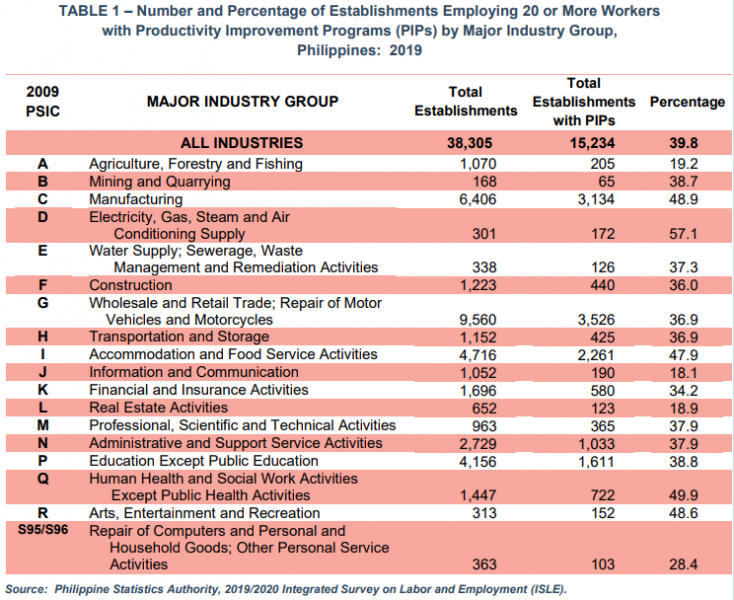
PRODUCTIVITY IMPROVEMENT PROGRAMS IMPLEMENTED
- Of the various productivity improvement programs implemented by establishments, 7S of good housekeeping was the most common which was implemented by 54.9 percent of the total establishments with PIPs. Other programs widely implemented include Client Satisfaction Measurement (CSM) (45.0%); Suggestion/Feedback Scheme (45.0%); Continuous Process Improvement (CPI) and Total Quality Management (TQM) at 44.1 percent and 43.8 percent, respectively. (Figure 1)
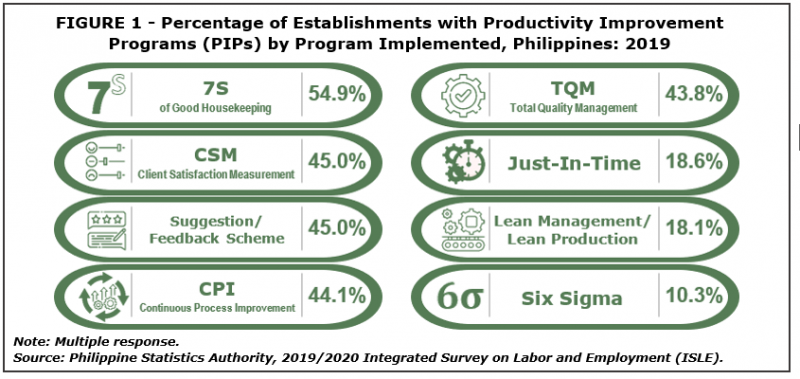
PRODUCTIVITY IMPROVEMENT PROGRAM DEVELOPER
- A great majority of the productivity improvement programs implemented by establishments in 2019 were initiated/developed by its management at 80.3 percent. Other program developers were supervisors/line leaders at 19.2 percent; labor-management committee at 13.3 percent; rank-and-file/production workers at 7.9 percent while union (2.5%) and productivity consultants (2.4%) were the least who developed/initiated the PIPs. (Figure 2)
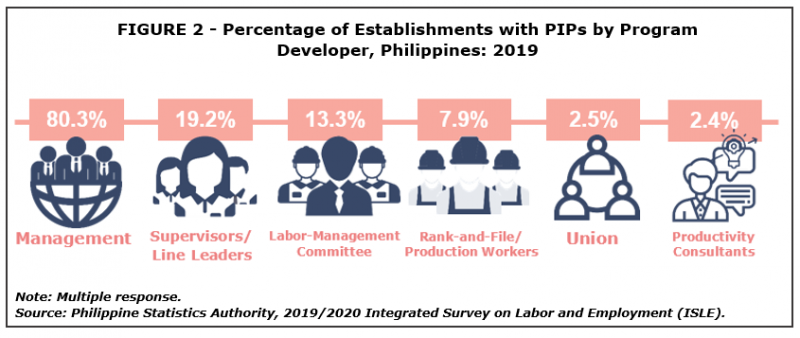
PRODUCTIVITY IMPROVEMENT PROGRAM OBJECTIVES
- In terms of the objectives of establishments for implementing their PIPs, improving product or service quality through skills training is the most cited (72.1%). Other objectives recorded were to: reduce complaints through basic customer service (50.8%); reduce cost in wastage (47.7%); improve product or service quality in technology (46.2%); reduce cost in work accidents/injuries/diseases (45.7%); and improve product or service quality through innovation (43.5%). (Figure 3)
- To reduce cost through process cycle time was the least reported objective among establishments with 29.3 percent share of the total.

COVERAGE OF WORKERS WITH PIP
- During the period, around 1.85 million workers were covered by the productivity improvement programs, 56.0 percent of which were male workers while the remaining 44.0 percent were female. Among those covered with PIPs, 84.5 percent were rank-and-file/production workers. (Figure 4)

REASONS FOR NON-ATTAINMENT OF PIP OBJECTIVES
- Topmost reasons specified by establishments for the non-attainment of the objectives of their productivity improvement programs were: lack of funds which was cited by 25.8 percent of the establishments with PIPs; lack of manpower or support from the employees with 13.0 percent; and change in the owner/s’ or management’s priorities with 6.2 percent. (Table 2)
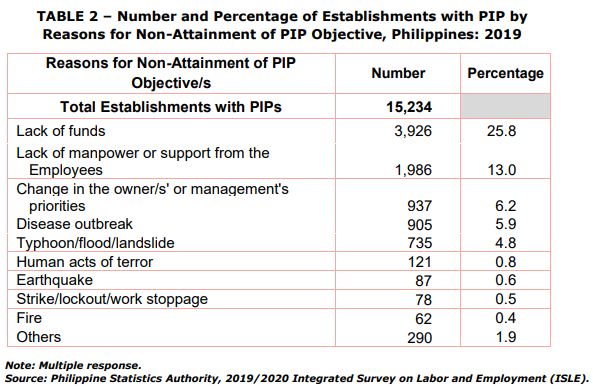
GAINSHARING SCHEMES/PRACTICES IN ESTABLISHMENTS WITH PIPs
- More than half (8,162 or 53.6%) of the establishments with PIPs have gainsharing schemes/practices or provided incentives or bonuses for improved performance of employees. In gainsharing, provision of cash was the usual practice of around 30.2 percent of establishments with PIPs. Same can be observed in terms of profit sharing with cash provision recorded at 5.6 percent. Other establishments provided employee stock/s option plan in cash at 5.3 percent. (Table 3)

USUAL FORM OF NON-CASH INCENTIVE
- Among establishments with gainsharing schemes that provided usual form of non-cash incentives (2,417) to their employees, grocery items was the most common at 42.3 percent. Other forms of non-cash incentives given were gift certificate/cheque at 36.6 percent, subsidized travel/leisure at 20.7 percent and home appliances at 3.2 percent. (Figure 5)

EMPLOYEES BENEFITTED FROM THE PIP INCENTIVES
- A total of 878,399 workers was benefitted from the PIPs incentives. About 4 out of every 5 (82.8%) of these were rank-and-file/production workers. Supervisors/foremen comprised of 9.7 percent and managerial/executive at 7.4 percent. (Figure 6)

ASSISTING GOVERNMENT AGENCY
- Department of Labor and Employment (DOLE) had provided assistance to most of the establishments in the development and implementation of their productivity improvement programs. In particular, the DOLE supported one of every five (21.9%) of total establishments with PIPs. Regional Tripartite Wage and Productivity Board (RTWPB) likewise provided assistance accounting for 7.7 percent while the Department of Trade and Industry (Negosyo Center) assisted 3.1 percent of the establishments with PIPs. (Figure 7)
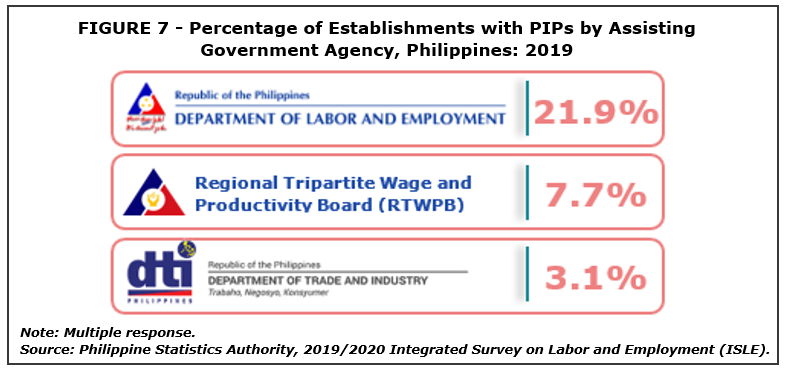
ASSISTANCE FROM RTWPBs
- Of the total establishments (38,305), only few (9.0%) had attended training programs conducted by RTWPBs. However, around 72.8 percent of which have implemented PIPs after their attendance to RTWPBs training programs. (Table 4)

- Some or 33.9 percent of the establishments with PIPs considered training as the technical assistance they needed from RTWPBs. This was followed by consulting and information materials with 19.1 percent and 18.6 percent shares, respectively. (Figure 8)
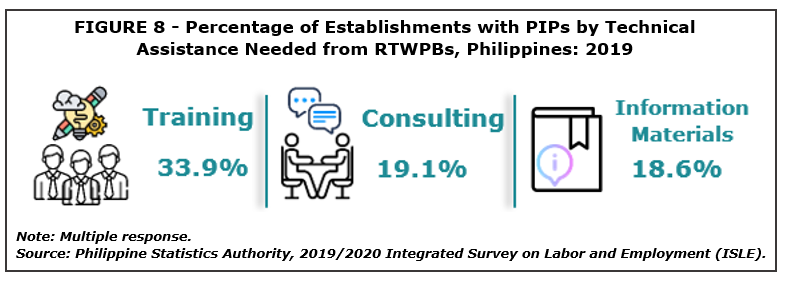
COVID-19: Impact of Recovery Measures
IMPACT OF QUARANTINES/LOCKDOWNS ON BUSINESS OPERATIONS OF ESTABLISHMENTS IN 2020
- Around 72.5 percent of establishments stated that their business operations were affected by quarantines and lockdowns during the COVID-19 pandemic. As of June 2020, seven out of eleven (64.1%) establishments cited that their sales position was decreased as compared to June 2019 while almost half (48.3%) had adopted reduced working hours on their business operations.
- Other impacts of quarantines and lockdowns during COVID-19 outbreak were: reduction of the cost of production inputs (45.4%); implementation of Work-From-Home arrangements (36.6%); and temporarily laid-off workers (16.9%). (Figure 9)
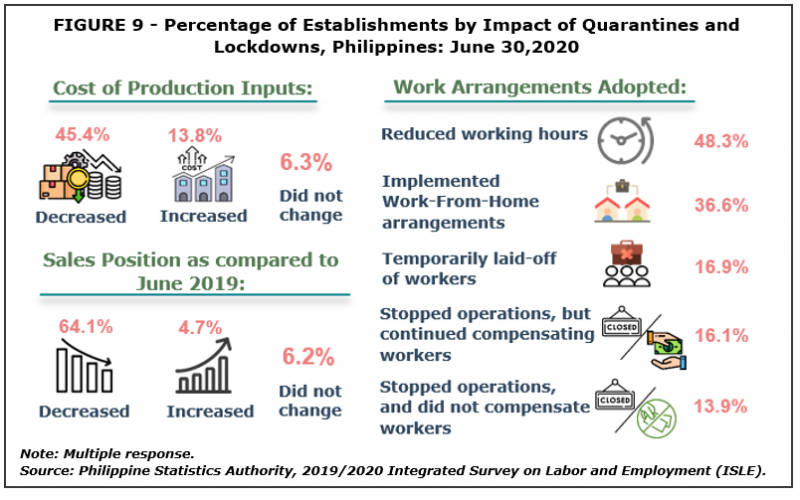
SOURCES OF FUNDS DURING QUARANTINE/LOCKDOWN
- Four out of nine (44.5%) of establishments reported that they have different sources of funds to continue their operations/stay liquid during the pandemic in 2020.
- The topmost source of funds was the delayed payments to suppliers with 45.7 percent followed by request for early payments from customers with 33.1 percent and availment of loans from banks with 24.5 percent. (Figure 10)

BUSINESS RECOVERY MEASURES/ACTIONS FOR THE NEXT SIX MONTHS
- Various measures were recorded in 38.3 percent of the establishments in 2020 as part of their business action plan to attain recovery from the pandemic in the next six months.
- Among type of business actions being considered, request from the government for delayed payments on taxes, SSS contributions, etc. topped the list at 46.5 percent. Other business actions identified were to lay-off workers and to reduce employees’ wages/salaries at 25.4 percent and 23.5 percent, consecutively. The least measure was to apply for bankruptcy at 0.4 percent. (Figure 11)
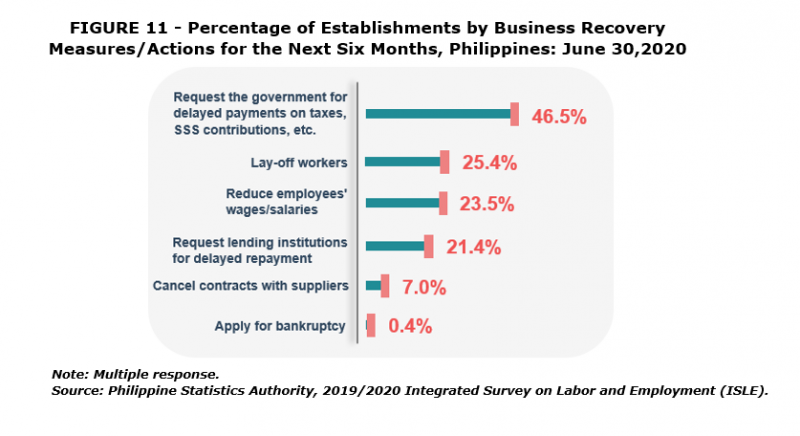
DENNIS S. MAPA, Ph.D.
Undersecretary
National Statistician and Civil Registrar General
See more at the Integrated Survey on Labor and Employment Landing Page.
Survey Information:
This module on Productivity Improvement Program and Gainsharing Practices (PIPGP) is a rider module from the National Wages and Productivity Commission (NWPC) which gathers data on the following: (1) characteristics of Productivity Improvement Programs (PIPs) developed and implemented in establishments; (2) objective/s of the PIP/s and status of attainment of these objectives; (3) number of managers, supervisors and rank and file employees covered by PIP/s; (4) reason/s for the non-attainment of PIP objectives; (5) type/s of gainsharing schemes/practices included in the PIP/s and types of forms the incentives were given; (6) number of managers, supervisors and rank and file employees who benefitted from the incentives under the gainsharing schemes/practices; (7) number of establishments that avail of tax incentives for PIPs implemented; (8) government agencies that assisted establishments in the development and implementation of PIPs; (9) number of establishments who attended RTWPB training programs; (10) number of establishments that implemented PIPs as a result of attending RTWPB training programs; (11) frequency of visits/monitoring done by the RTWPBs to establishments in relation to the implementation of the PIPs; and (12) other types of technical assistance establishments’ need from the RTWPBs to improve productivity and performance of the establishments.
For this survey round, to assess the impact of recovery measures adopted by establishments to counter the effects of COVID-19 pandemic, additional questions include: (1) effect/s of quarantines/lockdowns on business operations of establishments, (2) source/s of funds of establishments to stay liquid during quarantines/lockdowns; and (3) business action/s considered by establishments for business recovery in the next six months.
The PIPGP module will generate the needed data/information on the existing patterns/trends on productivity improvement and gainsharing practices developed and implemented in establishments across industries. Data generated on PIPGP are also valuable inputs to studies on industry trends and practices in establishments for planning and program formulation of policymakers and decision makers in the government. In addition, the module is a major source of information on the impact of recovery measures done by establishments during the quarantines/lockdowns due to COVID-19 pandemic. The data generated from this module will provide the necessary inputs to the NWPC in identifying the types of productivity tools that are needed to be developed to address productivity issues at the workplace during the pandemic period.
DEFINITION OF TERMS:
Productivity Improvement Program – workplace programs aimed at improving worker and/or enterprise productivity.
“Developed by” – refers to an individual or group of persons who take steps and tasks such as, but not limited to initiate, conceptualize, strategize, organize and evaluate productivity program.
7S of Good Housekeeping – refers to a training program on waste elimination through workplace organization. 7S means sort, set in order, shine, standardize, sustain, safety and spirit.
Client Satisfaction Measurement (CSM) – refers to the assessment of performance from the customer's point of view.
Total Quality Management (TQM) – management philosophy that seeks to integrate all organizational objectives.
Lean Management – refers to a productivity program on doing more with less, i.e., less time, inventory, space, labor and money.
Suggestion/Feedback Scheme – formal mechanism which encourages employees to contribute constructive ideas for improving their organization.
Six Sigma – refers to a program aimed at the near elimination of defects from every product, process and transaction.
Just-in-Time – refers to a production technology system which promotes economic efficiency, with a central principle of “produce appropriately what is necessary, just as much as needed, when needed”.
Continuous Process Improvement – act of implementing improvements to a product, service or process.
Gainsharing – refers to a group incentive or bonus system that shares improved performance with most or all employees of a unit and thus motivates higher employee involvement. (OECD)
Profit Sharing – refers to a definite arrangement under which workers regularly receive, in addition to their wages and salaries, a share on some pre-determined basis, in the profits of the undertaking, the sum allocated to workers varying with the level of profits. (OECD)
Employee Stock/s Option Plan – refers to a form of equity compensation granted by companies to their employees and executive. An ESO gives the holder the right to purchase the underlying asset – the company’s stock – at a specified price for a finite period of time. (Investopedia)
Usual Form – refers to the common form of non-cash incentives (gift certificate, electronic gadget, home appliances, etc.) given by the establishment to workers.
Productivity 101 – refers to a training program of the basic orientation on productivity concepts, measures, tools and techniques.
ISTIV-PAP (Productivity Awareness Program) – refers to training program of a values-driven human resource intervention for quality and productivity improvement rooted in the five ideal attributes of a productive individual.
I stand for Industrious, S for Systematic, T for Time-conscious, I for Innovative, and V for strong Value for work.
ISTIV-Bayanihan – refers to a training program and networking intervention for Barangay Micro Business enterprises that supports the growth of micro enterprises by enhancing the entrepreneurs’ way of managing the enterprises.
DOLE Integrated Livelihood and Emergency Employment Program (DILEEP) – refers to the program seeks to contribute to poverty reduction and reduce the vulnerability to risks of the working poor, vulnerable and marginalized workers either through emergency employment, and promotion of entrepreneurship and community enterprises. It composed of (a) Kabuhayan or DOLE Integrated Livelihood Program (DILP); and (b) Tulong Panghanapbuhay sa Ating Disadvantaged/Displaced Workers (TUPAD) or Emergency Employment Program.
ISTIV Plus-SIB (Succeeding in Business) – refers to a training program combining productivity values and techniques using knowledge dialogue mechanism between labor and management.
Green ME (My Enterprise) – refers to a training program for sustainable growth and environment protection that recognizes the workforce as the driver of change in the enterprise.
Service Quality – refers to a training program which is quality management intervention which makes used to prescribed tools and techniques in developing creative solutions to reduce errors in service.
Retail Service: Merchandising and Visual Merchandising – refers to a training program of the fundamentals of merchandising, marketing of the product, at the right price, in the right quantity, in the right place, at the right time. Visual Merchandising includes all aspects of the total visual impact of the store and its merchandise.
Social Media Marketing – refers to a training program that makes used of social media platforms and websites to promote a product or service
